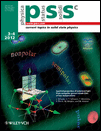A comparative study of UV electro-absorption modulators based on bulk III-nitride films and multiple quantum wells
Abstract
In this paper we present studies and compare the performance of UV electroabsorption modulators based on bulk GaN films and GaN/AlGaN multiple quantum wells. In both types of devices, the absorption edge at room temperature is dominated by excitonic effects and can be strongly modified through the application of an external electric field. We find that when similar active layer thicknesses and device geometries are employed, the electroabsorption modulators based on bulk nitride films can provide similar performance levels as those of GaN/AlGaN multiple quantum well devices. This should be compared to the case of arsenide, phosphide, or antimonide semiconductors, where the electroabsorption effect in quantum wells is an order of magnitude stronger than in the bulk. This is primarily due to the strong ionic character of the nitride semiconductors, which lead to very large exciton binding energies at room temperature (© 2012 WILEY-VCH Verlag GmbH & Co. KGaA, Weinheim)




